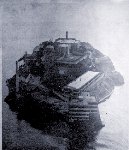| ||
| What were the cells like? | ||
Convicts in most American prisons shared their cell with another inmate. At Alcatraz they each had their own room which was about five feet wide, ten feet long, and about seven feet high. Each cell came equipped with a folding bunk, a chair, a toilet, a shelf and a washbasin. The Bureau of Prisons gave and allowed each man an aluminum drinking cup, a second one with a cake of shaving soap, a shaving brush, a metal mirror, a bar of regular soap, a toothbrush, tooth powder, a comb, a pair of nail clippers, a sack of low-grade tobacco, a corn-cob pipe, toilet paper, shoe polish, face and bath towels, a wisk broom for sweeping out the cell, a rule book, and a safety razor sans razor blade. (Prisoners weren't allowed to keep their razor blades. Three times a week, an orderly brought the inmate his own numbered blade. The convict then had half an hour to spruce himself up before the orderly collected the blade. Prisoners had to learn to tolerate cold water when they shaved.) Anything else a prisoner wanted to keep in his cell had to be approved by the staff. Common personal possessions included musical instruments, law books, art supplies, and solitary bridge games. Prisoners could not keep food in their cells except at Christmas when each of them was given a box of candy. They had one month to eat their treat or forfeit it. Each cell was a little box inside the bigger cell block. Most Alcatraz cells did not have individual locks on the doors. The gates to the cell were opened by remote control. When a prisoner wanted to go into his cell, he had to wait outside, holding the bars of the cell with one hand as the guard to open it. The cells did not afford much privacy. Along Broadway, the prisoners stared across the corridor into another cell. They dressed and used the toilet in full view of other convicts and the guards. Passing things from cell to cell was prohibited, but in this way convicts managed to share contraband. Contraband included many things including shivs (handmade knives), candy, chewing gum, drugs, and newspaper clippings. (Alcatraz authorities did not allow prisoners to read daily newspapers or magazine articles about crimes.) Warden Johnston's men enforced a Rule of Silence during the early years. At no time could prisoners in the cell house talk to one another. Some got around the letter of the rule by learning sign language. Prisoners had to be in their cells at night, before and after each meal, and whenever they had no assignment in the industries. Guards counted the prisoners several times each day and night, shining a light into their faces to be sure that each man was in his bunk. To see some pictures of the cells as they appeared in 1941, click here. |
